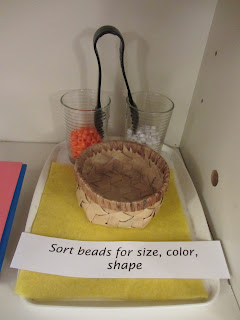- sorting activities (which is a pre-math skill),
- pin-poking shapes, such as a continent or country puzzle piece (which aids in handwriting),
- sewing,
- playing a melody harp (which gives a gentle calm to the bustling classroom environment),
- cooking food to share with the class,
- making designs on a geometric board with colorful rubber bands,
- building architectural models of real buildings which we are currently studying,
- gardening (or watering indoor plants during winter months),
- doing yoga exercises (asanas) with a partner or by oneself,
- and walking a peace labyrinth.
Practical Life activities build a child’s motor development from fine to gross -- strengthening both the pincer grip involved in legible penmanship and the patience needed to remain engaged with a project for a length of time. Practical Life also provides students with opportunities to explore their senses and enjoy activities related to the life of the community. Practical Life is indeed a “practical” skill which the child notices improves the more s/he practices it. A child is intrinsically motivated to cook, to sew, or to build.
This type of activity grounds a person emotionally and physically, allowing him/her the space and time to make something beautiful, delicious, or intricate. In this way, the spiritual life of the Montessori student blossoms, in giving to others and in caring for oneself. Practical Life is the essence of Montessori's Peace Education.











